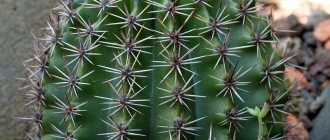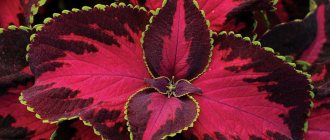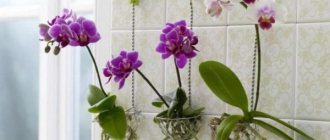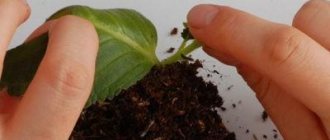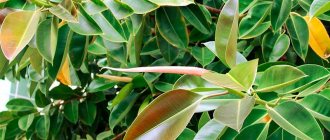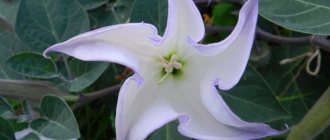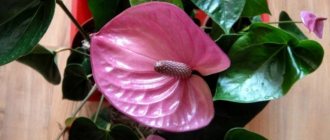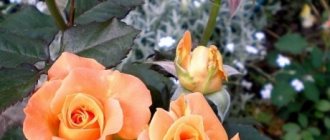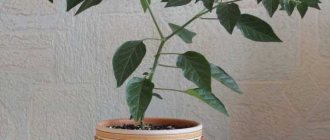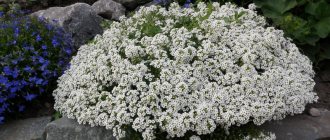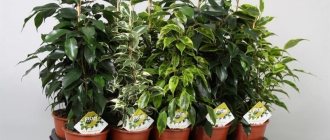The aglaonema plant can often be found in residential and office buildings. This is a very popular representative of the flora, which will decorate the room with lush and dense greenery. China, Southeast Asia, and India are the birthplace of Aglaonema.
Indoor aglaonema belongs to evergreen herbs (semi-shrubs) from the Araceae family. Experts note that this plant is a “relative” of Dieffenbachia.
This is an ideal plant for the home, because aglaonemas bloom and bear fruit at home much more often than in the wild. In addition, it takes much longer to grow in apartments.
How to care?
Aglaonema is an unpretentious plant, but in order to create favorable conditions for its cultivation, one should remember that it is a shade-loving flower, and therefore the conditions must be appropriate.
Illumination
The ideal place for growing aglaonema will be the windowsill of an eastern window , where it will not receive direct sunlight. To grow a flower, you need to provide it with partial shade. If it is not possible to grow aglaonema on the eastern side, then it is necessary to artificially create partial shade. Direct sunlight will lead to burns and further death of the plant.
Temperature
The optimal temperature for growing aglaonema is from 20 to 25 degrees. The plant should be grown indoors without sudden temperature changes and drafts. In winter, the temperature can be gradually lowered to 16-18 degrees.
Watering
Water for watering aglaonema should be soft. Watering should be done after the top layer of soil has dried.
Particular attention should be paid to watering during the growing season (spring, summer). In winter, you can water it a couple of days after the substrate dries.
Air humidity
Air humidity plays an important role in growing aglaonema, so it must be systematically sprayed with a spray bottle.
Soil for aglaonema
Aglaonema should be planted in a light substrate that conducts air and moisture well. You can buy a ready-made substrate or prepare it yourself. To do this, mix leaf soil, sand, peat in a ratio of 3:1:1. You can add charcoal to the resulting mixture for better drainage.
Feeding
Aglaonema is fed only during the period of active growth - from early spring to late summer. Fertilizers must contain nitrogen and potassium, and should not contain lime. Organic fertilizers alternate with mineral ones; they need to be applied once every 2 weeks. The permissible concentration must be indicated in the instructions on the fertilizer packaging.
Fertilizing should be done immediately after watering. It is recommended to apply fertilizing not only by watering, but also by spraying. But in this case, during feeding, the aglaonema should not be exposed to direct sunlight.
This may be interesting: Nerthera (Coral berry) - home care
Planting and transplanting
Landing
When planting aglaonema, there is no need to strongly compact the substrate around the plant, since the roots of the plant are fragile and easily break. If the roots have grown too long, this does not mean that they need to be trimmed. You need to carefully place the roots in a pot and sprinkle with soil.
Transfer
A young plant needs to be replanted every year, and an adult plant needs to be replanted every 3-5 years, as the bush grows. Aglaonema has a shallow root system, so you need to select a small pot.
If you choose a pot that is too large, the roots will take much longer to grow, which means flowering and fruiting will begin later.
Plant characteristics
Aglaonema is a herbaceous, evergreen plant.
The stems are straight, fleshy and dense. You can also find varieties with a branched trunk at the base. Young plants have practically no stem; it grows and becomes stronger during the development of the flower. Mature stems often retain traces of previously fallen leaves.
The foliage is patterned, leathery, on dense cuttings of varying lengths. For a visual acquaintance with this amazing flower, photographs of aglaonema have been added to the article. Naturalists note that the color of the leaves and their shape may vary depending on the variety.
During the flowering period, inflorescences form on the plant. They are located on the upper leaves. Just like the foliage, the shape and size of the aglaonema flower depends on the plant variety.
After the flowering period comes to an end, bright berries begin to appear, in which seeds ripen. Some plants have white berries. They ripen over several months (from 6 to 8).
How to root?
There are two ways to root cuttings:
- Water the mixture of sand and peat generously, and deepen the cuttings into the soil to half their height. Cover the cuttings with a plastic cap, thereby creating a greenhouse. The temperature in the greenhouse should be between 22-26 degrees. This is necessary so that the cuttings do not rot.
- On the first day, immerse the cuttings in a solution of root or heteroauxin, which stimulates rooting. Next, move them to a container with water and root them in water.
Reproduction
Spring is the ideal time for the propagation of aglaonema. Reproduction is carried out mainly using stem cuttings or shoots, sometimes by seeds.
It is better to cut species with vertical stems in this way:
- At ground level, it is necessary to cut off most of the plant and plant it in a pot with loose soil. The composition of the soil is exactly the same as when growing adult plants.
- The formation of roots begins from “dormant” buds in the stem.
- New shoots will appear from the aboveground part of the plant.
- Until the plant is completely rooted, it should not be over-watered.
Stem cuttings
Cuttings must be carried out not only to propagate the plant, but also when the aglaonema grows strongly and its presence in the pot becomes unstable.
- The most overgrown stem is selected and cut off at a level of 2-3 cm above the soil.
- Divide the shoot into several 5 cm pieces.
- Each shoot should be cleared of leaves.
- To root, you need to take a box, fill it with drainage, and fill it with a mixture of sand and peat.
- After the cuttings have given roots, they should be planted in separate pots. The soil should be used as for replanting.
Cuttings with lateral shoots
You can take cuttings not only from the stems of aglaonema, but also from the lateral shoots.
- First you need to water the soil generously, then carefully remove the aglaonema from the pot.
- Clear the roots from the soil and separate the daughter shoots from the main part of the plant.
- Plant in separate pots, watering regularly and controlling air humidity.
- The soil will be exactly the same as when transplanting.
- Rooting ends with the appearance of new leaves.
Seeds
Aglaonema is a self-pollinating plant that bears fruit abundantly. Ripe seeds are found in brightly colored fruits.
Important! When the fruits come into contact with them, they leave a bright-colored powder on the skin, so it is better to pick them up with gloves.
Harvest the fruits when they are fully ripe. It is better to use only fresh seeds for planting.
- Remove the seeds from the fruit and rinse to remove the pulp.
- Deepen into moist sphagnum 1-1.5 cm.
- Set up a greenhouse by covering the container with film or glass. The humidity in the greenhouse should be high, and the temperature should be between 20-26 degrees.
- Shoots will appear in 20-25 days. Sometimes shoots appear later.
- After the rosette grows to 5-7 cm in diameter, it should be picked and transplanted into a pot with a substrate consisting of a mixture of universal soil, peat and perlite in equal proportions. You can add charcoal or steamed bark to the soil.
Common varieties
Vriesia - home care, how Vriesia blooms
There are 20-50 subspecies of the Araceae family of indoor Aglaonema plants. The main varieties of the crop are classified into three groups according to the height of the bush.
Low-growing aglaonemas grow with drooping or creeping stems with a maximum height of 25 cm. Among the plant varieties, there are three popular varieties:
- Aglaonema short-covered is easily recognized by its elongated oval green foliage. White veins run down the middle of the leaves. The culture develops slowly and produces few leaves. To obtain a beautiful bushy plant, 2-3 seedlings are planted in one flowerpot.
- Aglaonema ribbed is a small bush with an underground or creeping branching stem. Heart-shaped foliage attracts with a mix of white or green colors, many spots and stripes. The individual loves to delight its owners on New Year's Eve with an inflorescence reaching a height of 10 cm. After a few days, the flower falls off and the plant enters a dormant period.
- Aglaonema roundish has heart-shaped leaves of brown and red tones. Bright pink stripes are drawn along the length of the sheet.
Popular varieties of aglaonema
Medium-sized flowers include aglaonema with straight trunks containing oblong leaves up to 30 cm in length. The most popular varieties are:
- Aglaonema Maria is a shrub with dense dark green foliage. The culture is shade-tolerant and takes root well in houses with artificial lighting. There is a variety called Maria Christina with silver-gray leaves.
- Treiba. The plant is characterized by small leaves 15 cm long, green in color and silvery pattern.
- Aglaonema is modest. 50 cm high, strewn with round-shaped leaves with convex veins and sharp tips. Leaf length is maximum 20 cm.
- Silver Queen - stretches up to 40 cm and needs good lighting, the surface of the leaves is silver-blue.
- Crete is a type of aglaonema with variegated pink-green leaves. More demanding of lighting compared to other varieties.
High varieties were obtained on the basis of shade-tolerant subspecies of Aglaonema, look good as single varieties and fit well into large-sized compositions. The most famous:
- Pattaya Beauty is an elegant bush with a thin, slender trunk, overgrown with large foliage with clearly visible green edges and a light gray core. In adults, the leaves darken. The Pattaya Beauty variety is ideal for rooms with low lighting, temperature changes and dry air. The measure of the shedding of the lower leaves of the plant is similar to that of a palm tree.
- Aglaonema Friedman grows up to 1.5 m. Wide and large foliage has wavy edges. Silvery spots are formed in the center of the leaves, and dark green dots along the edges.
- Silver Bay is an impressive crop growing on a 1 m high trunk. The individual branches from the root system, the stem becomes bare slowly, and the bush retains its lush shape for a long time. The sharp, raised leaves gain a length of 30 cm. The area of light green leaves is completely covered with gray spots.
Silver is the most cold-resistant variety of aglaonema
On a note. Among the favorite varieties of aglaonema, the Silver variety is the most resistant to cold.
Diseases and pests
Aglaonema can be attacked by:
- Spider mite. It affects leaves and stems on which cobwebs appear. Treatment consists of spraying with Actellik or Akarin.
- Mealyworms. The leaves are affected, they begin to dry out, bend and fall off. Young shoots may also be affected. Treatment consists of spraying with Actellik or Akarin.
- Aphid. It affects the leaves, they become sticky and deformed. Treatment consists of spraying with Decis or Aktara.
- Thrips. It affects leaves, on the upper side of which black or green pellets form. Treatment consists of spraying with Intavir or Aktara.
Aglaonema is not susceptible to disease, but improper care can cause some difficulties in growing.
- The leaves begin to wrinkle and the edges turn brown. This is due to dry air. The plant must be moved to a more humid room or sprayed with a spray bottle.
The leaves curl. The reason may be the appearance of drafts in the room. In this case, the plant must be moved to another room, or drafts must be eliminated.
- The appearance of yellow spots. This is a consequence of sunburn. Most likely, the plant is standing in a sunny window, which is harmful to its health. It is advisable to change the place of residence of the aglaonema or shade it.
- Plant growth stops and brown tips appear on the leaves. This may be due to cold or hard water. Water the plant only with settled water at room temperature. If watering is carried out correctly, then the reason is the hardness of the water; to lower the level, you can add citric acid to the water (dilute 1-2 g in 1 liter of water).
Also read about the types of aglaonema plant.
Aglaonema splendor
A very widespread variety. The maximum height of the stems reaches one meter.
The leaves are painted a rich green color and the top is shiny, which is how this variety got its name. The maximum length of foliage is 45 centimeters and width is 20 centimeters.
How to take care of indoor flowers in the fall: useful tips and tricks
- How to choose a bouquet for March 8: the meaning of flowers and their quantity
TOP 10 best flowers as a gift on March 8
The leaves are turning yellow, what should I do?
With proper care, the leaves of any healthy plant should not turn yellow. If the normal growing conditions for aglaonema are violated, problems with its health may begin. One of the signs that the plant is sick is yellowed leaves, there may be several reasons for this:
- Not enough moisture. Overdrying the plant leads to its death. Yellowed leaves indicate that the roots have been damaged, so immediate cuttings from the tops are required. The cuttings are placed in the root and then planted in a substrate that is pre-watered. In order for the plant to take root faster, greenhouse conditions should be organized.
- Not enough space. When the flower has used all the nutrients from the soil, it becomes cramped in the pot; it needs to be transplanted into a larger pot. When replanting, the soil must be replaced. Feeding should begin two weeks after transplantation.
Can I keep it at home?
Aglaonema is a natural air purifier . The leaves of the plant are able to absorb compounds such as phenol, benzene, and formaldehyde that evaporate from polished or plastic surfaces. In addition, the leaves of the plant produce phytoncides that destroy streptococcus.
Based on the above, aglaonema brings many benefits to the home, but there is one limiting factor that prevents people from purchasing this plant. This is the opinion that aglaonema is a poisonous plant.
Important! Aglaonema, like most representatives of the aroid family, has a very caustic juice; its leaves should never be tasted.
Therefore, to the question “Is it possible to keep aglaonema at home?” There will be an obvious answer: you can, but if there are no small children in the house.
Aglaonema moderate (modest)
This plant is characterized by large oval leaves, 20 centimeters long and about 9 centimeters wide.
In the wild, this representative of the flora grows in the region of humid, tropical forests. The height reaches half a meter. The berries have a red, rich color.

